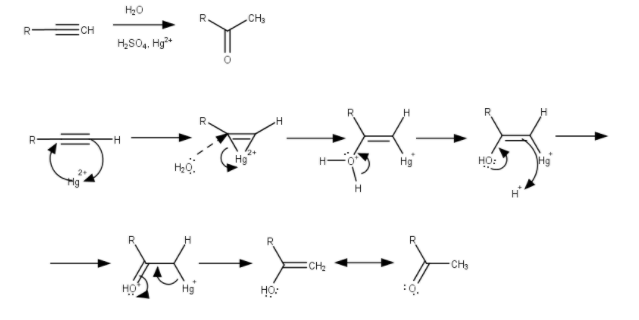Answer
385.5k+ views
Hint: The reactant alkyne reacts with ${H_2}O$ in presence of \[HgS{O_4}/{H_2}S{O_4}\] and forms a product. So, we have to think about the reaction in which alkyne reacts with ${H_2}O$ in presence of \[HgS{O_4}/{H_2}S{O_4}\] and then tautomerism because the compound ( $ \rightleftharpoons $ this sign shows that this compound is tautomerising itself) is changing itself.
Complete answer:
So, we have to start with the reaction in which alkyne reacts with ${H_2}O$ in presence of \[HgS{O_4}/{H_2}S{O_4}\]. So, that reaction is Alkyne Hydration.
Alkyne hydration:
So, we try to learn these reaction with an example,
So, let’s take an example,
$C{H_3} - C \equiv C - H + {H_2}O \to C{H_3}COC{H_3}$
Mechanism:

So, in case of unsymmetrical alkynes, the addition of water in the alkyne in according to the Markovnikov’s Rule, which states that the $O - $ atom will attach with the carbon having less number of $H - $ atoms and the two $H - $ atoms will attach with the carbon having greater number of $H - $ atoms.
But In these cases, the alkyne is symmetric.
So, we don’t have to follow any Markovnikov’s Rule,
And the reaction will be,
$H - C \equiv C - H\xrightarrow[{HgS{O_4}/{H_2}S{O_4}}]{{{H_2}O}}C{H_3}CHO$
Now, the $C{H_3}CHO$ will tautomerise itself,
So, let’s talk about tautomerism,
Tautomerism: When an aldehyde having one hydrogen atom, adjacent to the carbonyl group (i.e, \[\alpha \] carbon), this hydrogen can move to the oxygen atom of the carbonyl group and the double bond between the carbonyl group is shifted to the adjacent to the carbonyl group (i.e, \[\alpha \] carbon). This type of movement of bonds is called tautomerism and the compounds are called tautomers.
So, $C{H_3}CHO$ will tautomerise itself as

Hence, the complete reaction will be
${C_2}{H_2}\xrightarrow[{HgS{O_4}/{H_2}S{O_4}}]{{{H_2}O}}C{H_2} = CHOH \rightleftharpoons C{H_3}CHO$
Hence, the correct option is (D) $LiF$.
Note: While alkyne is reacting with ${H_2}O$ in presence of \[HgS{O_4}/{H_2}S{O_4}\] , we have to use the Markovnikov’s Rule when the alkyne is un-symmetric and when \[\alpha \] carbon is present, we must have to think once about the tautomerism.
Complete answer:
So, we have to start with the reaction in which alkyne reacts with ${H_2}O$ in presence of \[HgS{O_4}/{H_2}S{O_4}\]. So, that reaction is Alkyne Hydration.
Alkyne hydration:
So, we try to learn these reaction with an example,
So, let’s take an example,
$C{H_3} - C \equiv C - H + {H_2}O \to C{H_3}COC{H_3}$
Mechanism:

So, in case of unsymmetrical alkynes, the addition of water in the alkyne in according to the Markovnikov’s Rule, which states that the $O - $ atom will attach with the carbon having less number of $H - $ atoms and the two $H - $ atoms will attach with the carbon having greater number of $H - $ atoms.
But In these cases, the alkyne is symmetric.
So, we don’t have to follow any Markovnikov’s Rule,
And the reaction will be,
$H - C \equiv C - H\xrightarrow[{HgS{O_4}/{H_2}S{O_4}}]{{{H_2}O}}C{H_3}CHO$
Now, the $C{H_3}CHO$ will tautomerise itself,
So, let’s talk about tautomerism,
Tautomerism: When an aldehyde having one hydrogen atom, adjacent to the carbonyl group (i.e, \[\alpha \] carbon), this hydrogen can move to the oxygen atom of the carbonyl group and the double bond between the carbonyl group is shifted to the adjacent to the carbonyl group (i.e, \[\alpha \] carbon). This type of movement of bonds is called tautomerism and the compounds are called tautomers.
So, $C{H_3}CHO$ will tautomerise itself as

Hence, the complete reaction will be
${C_2}{H_2}\xrightarrow[{HgS{O_4}/{H_2}S{O_4}}]{{{H_2}O}}C{H_2} = CHOH \rightleftharpoons C{H_3}CHO$
Hence, the correct option is (D) $LiF$.
Note: While alkyne is reacting with ${H_2}O$ in presence of \[HgS{O_4}/{H_2}S{O_4}\] , we have to use the Markovnikov’s Rule when the alkyne is un-symmetric and when \[\alpha \] carbon is present, we must have to think once about the tautomerism.
Recently Updated Pages
How many sigma and pi bonds are present in HCequiv class 11 chemistry CBSE

Why Are Noble Gases NonReactive class 11 chemistry CBSE

Let X and Y be the sets of all positive divisors of class 11 maths CBSE

Let x and y be 2 real numbers which satisfy the equations class 11 maths CBSE

Let x 4log 2sqrt 9k 1 + 7 and y dfrac132log 2sqrt5 class 11 maths CBSE

Let x22ax+b20 and x22bx+a20 be two equations Then the class 11 maths CBSE

Trending doubts
Fill the blanks with the suitable prepositions 1 The class 9 english CBSE

At which age domestication of animals started A Neolithic class 11 social science CBSE

Which are the Top 10 Largest Countries of the World?

Give 10 examples for herbs , shrubs , climbers , creepers

Difference between Prokaryotic cell and Eukaryotic class 11 biology CBSE

Difference Between Plant Cell and Animal Cell

Write a letter to the principal requesting him to grant class 10 english CBSE

Change the following sentences into negative and interrogative class 10 english CBSE

Fill in the blanks A 1 lakh ten thousand B 1 million class 9 maths CBSE



